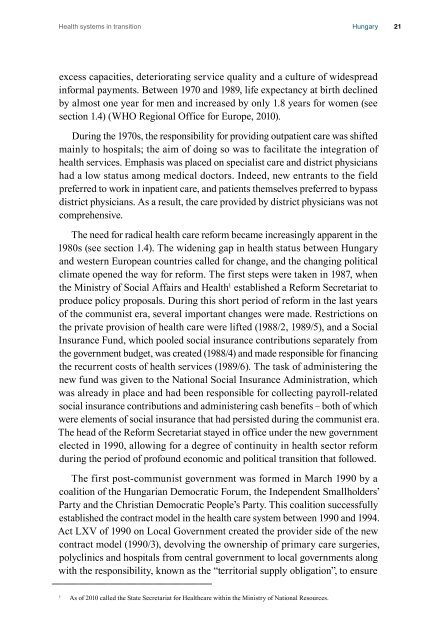Health Systems in Transition - Hungary - World Health Organization ...
Health Systems in Transition - Hungary - World Health Organization ...
Health Systems in Transition - Hungary - World Health Organization ...
Create successful ePaper yourself
Turn your PDF publications into a flip-book with our unique Google optimized e-Paper software.
<strong>Health</strong> systems <strong>in</strong> transition <strong>Hungary</strong> 21<br />
excess capacities, deteriorat<strong>in</strong>g service quality and a culture of widespread<br />
<strong>in</strong>formal payments. Between 1970 and 1989, life expectancy at birth decl<strong>in</strong>ed<br />
by almost one year for men and <strong>in</strong>creased by only 1.8 years for women (see<br />
section 1.4) (WHO Regional Office for Europe, 2010).<br />
Dur<strong>in</strong>g the 1970s, the responsibility for provid<strong>in</strong>g outpatient care was shifted<br />
ma<strong>in</strong>ly to hospitals; the aim of do<strong>in</strong>g so was to facilitate the <strong>in</strong>tegration of<br />
health services. Emphasis was placed on specialist care and district physicians<br />
had a low status among medical doctors. Indeed, new entrants to the field<br />
preferred to work <strong>in</strong> <strong>in</strong>patient care, and patients themselves preferred to bypass<br />
district physicians. As a result, the care provided by district physicians was not<br />
comprehensive.<br />
The need for radical health care reform became <strong>in</strong>creas<strong>in</strong>gly apparent <strong>in</strong> the<br />
1980s (see section 1.4). The widen<strong>in</strong>g gap <strong>in</strong> health status between <strong>Hungary</strong><br />
and western European countries called for change, and the chang<strong>in</strong>g political<br />
climate opened the way for reform. The first steps were taken <strong>in</strong> 1987, when<br />
the M<strong>in</strong>istry of Social Affairs and <strong>Health</strong> 1 established a Reform Secretariat to<br />
produce policy proposals. Dur<strong>in</strong>g this short period of reform <strong>in</strong> the last years<br />
of the communist era, several important changes were made. Restrictions on<br />
the private provision of health care were lifted (1988/2, 1989/5), and a Social<br />
Insurance Fund, which pooled social <strong>in</strong>surance contributions separately from<br />
the government budget, was created (1988/4) and made responsible for f<strong>in</strong>anc<strong>in</strong>g<br />
the recurrent costs of health services (1989/6). The task of adm<strong>in</strong>ister<strong>in</strong>g the<br />
new fund was given to the National Social Insurance Adm<strong>in</strong>istration, which<br />
was already <strong>in</strong> place and had been responsible for collect<strong>in</strong>g payroll-related<br />
social <strong>in</strong>surance contributions and adm<strong>in</strong>ister<strong>in</strong>g cash benefits – both of which<br />
were elements of social <strong>in</strong>surance that had persisted dur<strong>in</strong>g the communist era.<br />
The head of the Reform Secretariat stayed <strong>in</strong> office under the new government<br />
elected <strong>in</strong> 1990, allow<strong>in</strong>g for a degree of cont<strong>in</strong>uity <strong>in</strong> health sector reform<br />
dur<strong>in</strong>g the period of profound economic and political transition that followed.<br />
The first post-communist government was formed <strong>in</strong> March 1990 by a<br />
coalition of the Hungarian Democratic Forum, the Independent Smallholders’<br />
Party and the Christian Democratic People’s Party. This coalition successfully<br />
established the contract model <strong>in</strong> the health care system between 1990 and 1994.<br />
Act LXV of 1990 on Local Government created the provider side of the new<br />
contract model (1990/3), devolv<strong>in</strong>g the ownership of primary care surgeries,<br />
polycl<strong>in</strong>ics and hospitals from central government to local governments along<br />
with the responsibility, known as the “territorial supply obligation”, to ensure<br />
1 As of 2010 called the State Secretariat for <strong>Health</strong>care with<strong>in</strong> the M<strong>in</strong>istry of National Resources.
















